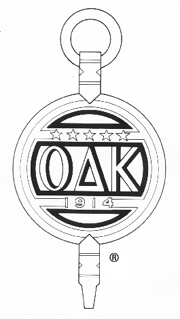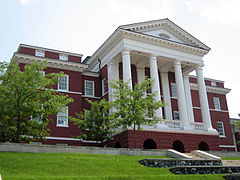Omicron Delta Kappa
This article needs additional citations for verification. (April 2010) |
| Omicron Delta Kappa | |
|---|---|
| ΟΔΚ | |
 | |
| Founded | December 3, 1914 Washington and Lee University |
| Type | Honor society |
| Affiliation | HSC |
| Former Affiliation | ACHS |
| Status | Active |
| Scope | National |
| Motto | "Success Achieved in Worthy Undertakings" |
| Colors | Sky blue, White, and Black |
| Symbol | A Laurel with Stars |
| Flower | Blue delphinium |
| Publication | The Circle |
| Chapters | 300+ active; 418 chartered |
| Members | 330,000+ lifetime |
| Headquarters | 224 McLaughlin Street Lexington, Virginia 24450 United States |
| Website | odk.org |
Omicron Delta Kappa (ΟΔΚ), also known as The Circle and ODK, is an honor society located in the United States with chapters at more than 300 college campuses. It was founded on December 3, 1914, at Washington and Lee University in Lexington, Virginia, by fifteen student and faculty leaders. The society recognizes achievement in five areas: scholarship; athletics; campus and community service, social or religious activities, and campus government; journalism, speech, and the mass media; and creative and performing arts. Some circles of ΟΔΚ are quasi-secret, in that newly selected members remain undisclosed for some time.
Membership in the Omicron Delta Kappa Society is regarded as an honor in the tradition of Phi Kappa Phi, Phi Beta Kappa and Tau Beta Pi. To be selected as a member of ΟΔΚ, students must be among the top 35 percent of all students at that particular institution and hold a leadership role in one of the society's five areas of recognition.
History
[edit]
Founding
[edit]On December 3, 1914, the Omicron Delta Kappa Society was founded by fifteen men who met in an office on the third floor of Reid Hall at Washington and Lee University. J. Carl Fisher first introduced the idea of creating such a society to a close friend, Rupert Latture. The two soon included mutual friend William Brown in the discussion, and thus these three are referred to as the principal founders of the society. Together with the president of the University, the dean of engineering, and another faculty member, the founders selected nine others to join them. A complete list of the fifteen founders follows:[1]
- James Edwin Bear, ΒΘΠ, editor of the student magazine
- William Moseley Brown, ΔΚΕ, ΦΒΚ, debater and president of the YMCA
- Carl Shaffer Davidson, ΚΣ, student instructor in civil engineering
- Edward Parks Davis, ΚΣ, athlete
- Edward A. Donahue, ΦΚΣ, captain of football and baseball teams
- De la Warr Benjamin Easter, PhD, ΚΣ, ΦΒΚ, professor and the founding president of ΟΔΚ
- James Carl Fisher, business manager of the student magazine and founder of the campus radio station
- Philip Pendleton Gibson, ΠΚΑ, president of student government and editor of the student newspaper
- Thomas McPheeters Glasgow, ΦΔΘ, orator and athlete
- David Carlisle Humphreys, FIJI, professor and dean of the School of Applied Science
- Rupert Nelson Latture, ΔΥ, ΦΒΚ, a president of the YMCA
- John Eppes Martin, ΑΧΡ, business manager of the yearbook
- William Caulfield Raftery, ΦΚΣ, athlete
- John Purver Richardson Jr., ΣΧ, instructor in biology
- Henry Louis Smith, PhD, ΦΔΘ, ΦΒΚ, president of Washington and Lee University

All fifteen men were prominent leaders on campus. The rallied around the idea that all-around leadership in college should be recognized, that representative men in all phases of college life should cooperate in worthwhile endeavors and that outstanding students and faculty should affiliate in the spirit of mutual interest and understanding. The founders intended that ΟΔΚ not be yet another society in which members would simply earn a societal key. Instead, members of ΟΔΚ would remain active as leaders, upholding spiritual and moral values and providing service to the campus and community.

The founders decided that the organization would be kept a complete secret until keys could be designed and produced. The keys arrived shortly past the winter holiday. The student newspaper, Ring-Tum Phi, broke the news on d January 12, 1915, of a new society to be known as "The Circle," with the secret significance of its three Greek letters known only to its members.[2][3] The members first wore their keys on January 15, 1915.
Women in ODK
[edit]Only men could become members of Omicron Delta Kappa in the first sixty years of its existence. At the 1970 and 1972 National Conventions, the University of Alabama Circle introduced an amendment to the national constitution to admit women into the society. In June 1972, Title IX of the "Education Amendments Act of 1972" prohibited sex discrimination in federally assisted educational programs and amended parts of the Civil Rights Act of 1964. Professional and honor fraternities were included in Title IX. The society's special committee on the possible role of women met in January 1973 and recommended changes to the national constitution that would abolish segregation based on gender within the Society. On March 12, 1974, the national convention convened in New Orleans and approved the initiation of women into the society. The first women members were initiated that day, including Carolyn Julia Kucinski, and Diane Christine Ragosa of the Newark College of Engineering Circle and Robbie Lynn Cooney, Maria Dolores Delvalle, Roxane R. Dow, Catherine Ann Rohrbacher, Karen Diane Janzer, Linda Ann Touten, Martha Gwyn Van Deman, and Cathy Sue Welch of the University of South Florida Circle.
Cheryl Hogle was elected as the first woman national president at the convention in Knoxville, Tennessee on February 25, 1998.[4]
Affiliations and memberships
[edit]A similar honorary society, for exceptionally outstanding women leaders, known as Mortar Board, was established in 1918, with many similar ideals and purposes of Omicron Delta Kappa. With the passage of Title IX in 1972, each of those two societies was then required to accept candidates of either gender into its membership. As a result, the two organizations found themselves competing to tap many of the same distinguished students, and those formerly complementary societies became rivals at many institutions, perhaps fiercely so during membership selection, while more congenially so during the rest of the year, as the two rivaled one another in service, athletics, or other campus activities.
On March 22, 1992, the national convention passed a resolution authorizing the incorporation of the society. On July 1, 1992, the Omicron Delta Kappa Society was merged into the corporation, The Omicron Delta Kappa Society, Inc.
Omicron Delta Kappa became a member of the Association of College Honor Societies since March 30, 1930. It resigned that membership in 2005. Today, the society participates in a more loosely coordinated lobbying association called the Honor Society Caucus. Its members include Phi Beta Kappa, Phi Kappa Phi, Sigma Xi, and Omicron Delta Kappa.[5]
Membership
[edit]Unlike some honor societies that accept all potential members who meet the selection criteria and pay the required fees, ΟΔΚ chooses a highly select group from a pool of potential and qualified students through a process known as tapping. Eligibility for membership in ΟΔΚ requires at least sophomore academic standing. ΟΔΚ accepts candidates from every field of study who distinguish themselves as outstanding leaders in at least one of the five areas celebrated by the society: scholarship; athletics; campus and community service, social or religious activities, and campus government; journalism, speech, and the mass media; and creative and performing arts. Members may be chosen annually or semi-annually depending on the tradition of each circle. The number of candidates tapped each year is limited to 35 percent of the undergraduate population, but most circles limit membership to fewer than the top one-quarter of one percent of the students on their respective campuses.
Once a circle votes on who will be tapped for membership, it keeps that secret from all but those few chosen for initiation. Once tapped, each candidate must maintain the secret until the circle reveals it to the campus and community in a public ceremony, only after the circle has initiated the new members into the bonds of the society through its private ritual. At some institutions, such as the University of Missouri, with several such elite societies that tap new members, the public revelations are all held in conjunction, with an annual ceremonial Tap Day celebration on campus.
Circles
[edit]Omicron Delta Kappa uses the term circle to indicate chapters. As of May 4, 2023, 431 circles have been chartered. The practice of automatically designating circles with Greek letter names was abandoned in 1949, although some circles have adopted Greek letter nicknames in later years. Members who have died are said to have entered the Eternal Circle.
Notable members
[edit]References
[edit]- ^ "New Honor Society – ' 'The Circle' '". Washington and Lee University Bulletin. Vol. XIV, no. 3. 1915. p. 22.
- ^ "Commemorating the Silver Anniversary, Omicron Delta Kappa Fraternity, 1914–1939"
- ^ "New Society formed for Washington & Lee". The Ring-Tum Phi. Vol. XVIII, no. 1. January 12, 1915. p. 7.
- ^ "Women in ODK"
- ^ "Honor Society Caucus | Honor Society". www.phikappaphi.org. Retrieved 2021-10-22.
External links
[edit]- Official Circle Website
- ODK (Omicron Delta Kappa) Collection (MUM00598) at the University of Mississippi, Archives and Special Collections.areass


 French
French Deutsch
Deutsch